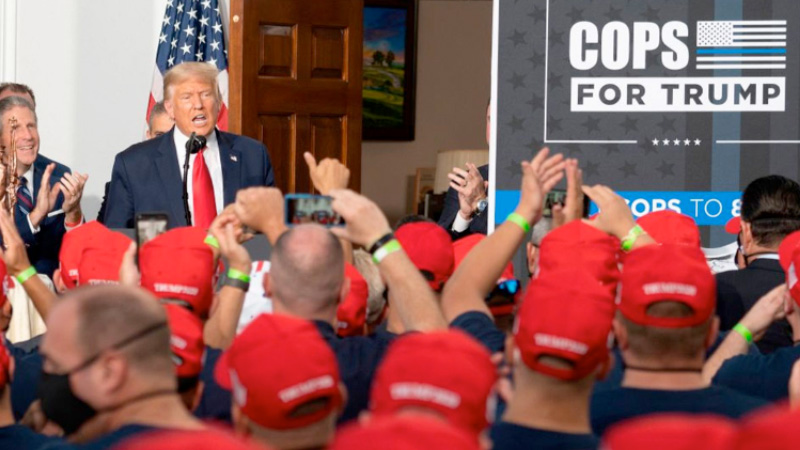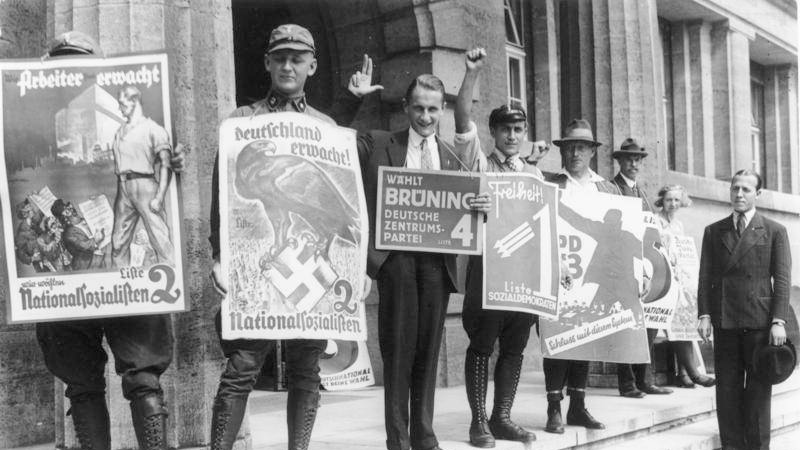The greater evil
A response to Charlie Post and Ashley Smith

Ashley Smith and Charlie Post present a case against lesser evil voting that is convincing neither in terms of logic or evidence.
They begin their analysis by telling us that Biden “appears headed for victory” but the “Democratic establishment” is “haunted” by the defeat of their sure-win candidate in 2016.
But it’s not just the Democratic establishment that is haunted by the failure to anticipate Trump’s victory in 2016. Anyone who cares about the future state of American society ought to feel chastened by the 2016 election and avoid glib predictions about 2020. Yes, the Democratic establishment got 2016 wrong, but so did much of the left. When the left touted polls showing Jill Stein garnering 3.5 and even 7 percent of the vote they were no less engaged in wishful thinking than were the corporate Democrats.
And though pollsters have improved their techniques since the debacle of 2016, the threat of unprecedented voter suppression and disenfranchisement, not to mention other ways in which Trump might try to steal the election, make the drawing of firm conclusions from Biden’s current lead in the polls especially dangerous this year.
Stein only ended up with 1 percent of the votes in 2016, but had her supporters instead cast ballots for Clinton in three battleground states, the election outcome would have been different. Trump was the result of rejecting lesser-evil voting—either by voting for Stein or by abstaining—yet in their analysis of the “trap” of lesser-evil voting, Smith and Post don’t discuss this rather significant case at all. Did the benefits of voting for Stein or staying home outweigh the horrors of Trump’s presidency? This seems relevant to the topic at hand, yet Smith and Post say nothing about it.
It is true that some Stein voters might have voted for Trump or stayed home if the Greens weren’t on the ballot, so we can’t actually know the impact of Stein’s candidacy on the outcome (though it’s hardly a ringing endorsement of a Green Party campaign that its appeal may be to Trump voters). But what matters is that Smith and Post are trying to convince those who are today wavering between the lesser evil and the Greens to vote Green. So, to the extent that they succeed, they will swing the election towards the greater evil.
Social Movements and Lesser-Evil Politicians
Smith and Post get wrong the relationship between electoral work and social movements, and use the recent anti-racist protests to try and make their case. They counterpose the victories of Black Lives Matter to the actions of lesser-evil politicians and in so doing misunderstand the way social reform takes place.
As an initial matter, the authors tell us that the “Black Lives Matter uprising scored more victories in a few weeks than decades of voting for the lesser evil.” Yet many analysts are rather less impressed with BLM victories than Smith and Post, noting that much of what has been accomplished is symbolic — removing Confederate flags and taking down statues – rather than fundamental changes in policing and criminal justice, where progress has stalled.
But let’s accept that Black Lives Matter victories have been substantive. Where did the victories take place? Almost all of them have been in Democratic states (like California and New York) or in Democratic-controlled cities. But on the national level, where the lesser-evils are not in control, the record is rather different. Trump issued an Executive Order but it offered “anemic reforms,” with “only cosmetic changes.” In Congress, where the Republicans hold the Senate, the bill that the Democrats passed in the House has been blocked.
It is absolutely true that left to their own devices, the Democrats have done and will do nothing. They need social movements, powerful social movements, to compel them to act. But it is also true that social movements can rarely push politicians who are beholden to the most reactionary forces in society. The Fraternal Order of Police and the International Union of Police Associations have both endorsed Trump for re-election and Trump will accommodate their concerns, not those of Black voters. Lesser-evil Democrats, on the other hand, are beholden to Black voters, and therefore susceptible to pressure on this issue.

Take the example of Pentagon transfers of excess weapons and equipment to local police forces. This initiative, known as the 1033 Program, was instituted under George H. W. Bush and continued under subsequent administrations. Under Obama, huge transfers to local departments were made. But after the killing of Michael Brown in Ferguson, Missouri, and the Black Lives Matter movement that emerged, Obama felt compelled to issue an Executive Order modestly curtailing the program. So yes, without the pressure of social movements, Democrats won’t do much. And under the pressure of the movement, Obama acted. However, after the lesser evil was defeated in 2016, Trump issued his own Executive Order, reversing Obama’s. Thus, today – despite what has been by some measures the largest protest movement in U.S. history – we are worse off in terms of the legal status of military equipment transfers to local police than we were under the last lesser-evil president.
Other Examples of the Relationship
The September 2019 climate strike was a huge mobilization, with 250,000 people marching in NYC. But less than two months later, the Trump administration gave formal notice of its intention to withdraw from the Paris climate accord. Despite the outpouring of environmental activism, we have seen a “stunning rollback in less than four years of environmental regulations that go back decades, including not just Obama-era climate change rules but even the National Environmental Policy Act, a bedrock law signed 50 years ago, which [Trump] has moved to unilaterally weaken.” Environmental activists could win a thousand local victories and they wouldn’t come close to reversing the new harms introduced by Trump.
And the pattern holds historically as well. The famous Selma to Montgomery march was a high point of social protest, with the tremendous dedication and heroism of the protesters moving the nation. But if there had been greater-evil Barry Goldwater in the White House, would the marchers have been protected by 3,000 federal troops and federalized national guard? Would Goldwater – who voted against the 1964 Civil Rights Act, who thought Brown v. Board of Education was “against the law,” and who opposed using federal troops to integrate Ole Miss – have pushed for the 1965 Voting Rights Act as lesser-evil Lyndon Johnson did?

The great sit-down strikes in Flint, Michigan, in 1936-37, represented a tremendous upsurge of labor militancy. But their success was not unrelated to the fact that lesser-evil Gov. Frank Murphy called out the National Guard not to evict the strikers, but to protect them from police and company thugs. Murphy also declined to follow a court order to expel the strikers. A month later, General Motors recognized the UAW.
So it’s not a question of lesser-evil politicians or social movements. Rather, it’s a question of which politicians will provide a more favorable environment for social movements. Movements need to get the most sympathetic politicians in office and then, when they’re in office, fight like hell to push them in a progressive direction.
Enabling the Right
Smith and Post tell us that “the lesser evil strategy always enables, rather than hinders, the growth of the right.” Note that they don’t say that sometimes the lesser evil strategy fails. They claim that it “always” enables rather than hinders the growth of the right. This claim is bizarre.
Smith and Post know that Trump has strengthened the right. They want us to know that lesser evils are not reliable, consistent, nor socialist opponents of the right. Granted. But that’s not the issue. The question is whether the right would be weaker or stronger today if those who rejected the lesser-evil strategy in 2016 – who voted for the Greens or who abstained in that election – had instead voted for Clinton.
Would the right be doing better today with Hillary Clinton in the White House rather than the past four years of Trump? Would Clinton have supported the white supremacist protesters in Charlottesville? Would she have filled the courts with the most rigidly far-right judges in decades? Would she have sent Homeland Security forces to Portland? Or pressured Homeland Security to underplay the role of white supremacists? Or emerged as an inspiration for the German far right?
Those who rejected the lesser-evil strategy in 2016 enabled Trump to win. Some who did so probably didn’t expect that outcome and may well regret their decision. But even in retrospect Smith and Post are claiming that it was those who voted for Clinton who “enabled” the growth of the right, not those who might have tilted the Electoral College towards Trump by rejecting lesser-evilism.
Why do shrewd rightwing operatives try to quietly promote the Green party? Is it because they think this will harm the right? Or is it because they know what most people know, namely that every vote that can be diverted from the Democrats to a third party with no chance of winning furthers the prospects of the right? Why did GOP operatives help try to get Kanye West on the ballot in Wisconsin? For the same reason.
Historical Examples
Smith and Post state that two historical examples “prove” their claim that “the lesser evil strategy always enables, rather than hinders, the growth of the right.” One is drawn from the Spanish Civil War, where the workers movement had to decide between social revolution and supporting the popular front government that was backed by the Communist party. This example seems particularly inappropriate to the current American context: there is no substantial workers movement, still less the possibility of social revolution. In any event, it’s not at all obvious that the workers movement would have been any more able to survive by taking the path of revolution given that they (and the Republic) had a desperate lack of weapons, which Stalin controlled, and given that they already didn’t need much incentive to fight in the face of the likely massacres that the fascists would commit upon their victory.
Their second example is the presidential election in Germany in 1932, where the Social Democrats supported Hindenburg to stop the Nazis’ rise, but Hindenburg ended up appointing Hitler chancellor. It’s true that voting for Hindenburg didn’t block Hitler, but was there a better, non-lesser evil strategy? Here are the results of the second round of voting (where only a plurality was needed):
- Hindenburg / Independent 53.0
- Hitler / Nazis 36.8
- Thälmann / Communists 10.2
The Social Democrats (SPD) were about 20 percent of the electorate. What would Smith and Post have had them do? Vote for Thälmann? Then Hitler wins. Run their own candidate? Then Hitler wins again. Now maybe this makes no difference at all, but it’s hard to see why having Hitler take power a year before he actually did would have been a great victory. Nevertheless, this is supposedly a decisive piece of historical evidence against lesser evil voting.

Germany in those years of course offers another lesson about lesser evilism, but not the one mentioned by Smith and Post. The Communist Party (KPD) considered the SPD to be “social fascists,” given its collaboration with capitalist parties and its support for authoritarian and austerity policies. It may have been a lesser evil than the Nazis, but to the KPD it was still evil and thus the KPD refused to partner with it in a United Front to oppose the Nazis, with disastrous consequences.
If one were actually concerned with relevant historical evidence then one would look at cases where progressives had a choice between voting for a lesser evil or for their preferred candidate who had no chance of winning, and try to assess the costs and benefits of each of the voting options. Sometimes this assessment will lead to the conclusion that one should vote for the lesser evil and sometimes not. Sometimes the assessment will be a close call. But Smith and Post never undertake this assessment generally, and they don’t do it for the 2020 U.S. presidential election in particular, where the difference between the two major party candidates is one of the most extreme in modern history.
Short-Term and Long-Term Impacts
It is sometimes suggested that we unfortunately need to accept some short-term pain of the greater evil in order to get future benefit. So we have to accept the greater evil now because we are building the movement and institutions that will give us substantial long-term progressive change.
But the long-term and the short-term are not so simply separated. In the short run, Trump undermines democracy by disenfranchising voters and by appointing rightwing judges who will be issuing rulings for decades to come. And these are not just short-run harms; they hurt the long-term prospects for social change. Had a few thousand Nader voters in Florida in 2000 cast votes instead for the lesser evil, George W. Bush might not have had the opportunity in his second term to elevate John Roberts and Samuel Alito to the Supreme Court, rather than two justices who might have been chosen by a re-elected Al Gore. That outcome led to the 5-4 decision in Shelby County v. Holder, gutting a key provision of the 1965 Voting Rights Act, with long-term negative consequences for the political clout of African Americans. (Gore needn’t have chosen Angela Davis to the Court; one can assume any non-rightwing ideologue he chose would have voted with the four Clinton and Obama justices.) Likewise, Trump’s two new justices helped provide the 5-4 decision in Rucho v. Common Cause, allowing partisan gerrymandering far into the future.
There are many other short-term policies with awful long-term effects. Trump makes it harder for workers to unionize or exercise their rights. This reduces the long-term prospects for worker organizing and for building a labor party. Trump’s tax policies have made the rich richer, providing greater resources for rightwing causes over the long term. And of course, Trump’s dismantling of the environmental regulatory structure in the face of imminent irreversible climate catastrophe threatens long-term human survival, let alone long-term social progress.
So how do Smith and Post assess the costs and benefits of Trump versus Biden on these issues? They don’t mention Trump’s climate policies, despite environmentalists’ warnings that we have very few years left in which to avert disaster. They don’t mention the judiciary – except to say that Biden “backed the appointment of right-wing judges” (though he voted against Clarence Thomas, Rehnquist for chief justice, Roberts, and Alito). Labor rights are not mentioned at all. Democratic rights are discussed in their claim that Trump is not a literal fascist – true enough, but irrelevant to the question of whether he will institutionalize authoritarian structures. And if you think Trump has been dangerous to democracy so far, consider how much worse he will be as the judiciary becomes less of a check on him.
Spoilers
Smith and Post recommend third party campaigns in “one party” cities and towns “where we can’t be accused of being spoilers.” No disagreement there, but why don’t they care about being the biggest spoilers of all in the presidential contest?
Howie Hawkins offers an inadequate discussion of the spoiler issue (if the Democrats can’t beat Trump, “it’s their own damn fault,” don’t “blame the little Green Party”). But a party can be very small and still act as a spoiler in a closely contested race, or a race where one side uses massive voter suppression to overcome its lack of popularity. And whatever the faults of the Democrats, the left can’t control those; all it can control is its own contribution to the looming catastrophe. But where Hawkins provides an unconvincing discussion of the spoiler problem, Smith and Post don’t discuss the problem at all. They don’t acknowledge that if enough leftists listen to their advice and refrain from voting for Biden in battleground states, that could swing the election to Trump.
One can’t vote for Biden and still be critical of him, say Smith and Post. We shouldn’t be diverted into trying to “turn out the vote for someone who opposes everything we’re fighting for.” But this is an extremely misleading formulation. Yes, Biden opposes socialism and our radical agenda. But he doesn’t oppose our defense of DACA or our rejection of leaving the Paris climate agreement, the Iran deal, and nuclear arms control agreements, or our opposition to Homeland Security forces in Portland, or our call for Covid to be addressed with science, or our battle to protect reproductive rights and LGBTQ+ rights, etc., etc. Not all lesser-evil leftists who are trying to turn out the vote for Biden are doing it for Biden or for the Democrats. Many are doing it for the well-being of the American people, of the world’s people — and the future of the left.
Categories
We want to hear what you think. Contact us at editors@tempestmag.org. And if you've enjoyed what you've read, please consider donating to support our work:
DonateStephen R. Shalom View All
Stephen R. Shalom is a member of the New Politics editorial board.
